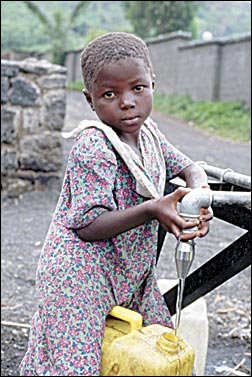“Housy - LifeStraws for Africa” Appeal
Please help us raise money to buy LifeStraws by donating as much as you can afford right now to HVRHS LifeStraws, c/o Mike DeMazza, Housatonic Valley Regional High School, 246 Warren Turnpike, Falls Village, CT 06031
Or read on ...
Just a few dollars from you will buy a Lifestraw that can provide drinkable water for an adult for a whole year. Please help us to raise as much as we can to really make a difference to people in time of devastating natural disaster.
There is no point in waiting until disasters strike - by then it is too late.
What is a LifeStraw?
The LifeStraw is a personal water purification device designed to turn surface water into drinking water, thus providing access to safe drinking water wherever you are. It was developed by a specialist commercial company, Vestergaard-Frandsen who research, develop and manufacture disease control textiles.
LifeStraws are approximately 25cm long with a diameter of 3cm, very light and of solid construction. It has a cord to place around your neck. It kills disease-causing micro organisms which spread diarrhea, dysentery, typhoid and cholera.
The LifeStraw contains a number of filters and a pharmaceutical pouch that cleans the water and treats it chemically. There are no electrical or moving parts and no maintenance is required - simply blow back after use to remove the debris that has been filtered.
Why are LifeStraws needed?
There is a massive need. More than one billion of the world’s population is without access to safe water, half suffer from waterborne diseases of which approx. 6000 people, mostly children, die every day from consuming unsafe water - even if we could help a small fraction of these people, what an achievement that would be.
LifeStraws can be used -
• For immediate use in disaster zones when the water supply is polluted or interrupted
• For populations on the move e.g. refugees or those in war zones
• For people working away from home all day - in fields on remote farms
• As emergency water purification for people in difficulty
What does it do?
By sucking through the LifeStraw the user can drink from surface water such as streams or rivers and it protects them from the micro organisms responsible for causing waterborne diseases. It will filter approx 700 litres of water - more than enough for one adult to survive for a year. After this it will become become clogged up and therefore inoperable.
Does it do what it says it does?
The efficacy of LifeStraws is backed up by data issued by the manufacturers. The LifeStraws website (www.lifestraw.com) has testing information.
How much do they cost?
The cost of a LifeStraw can be less than the price of a cup of coffee by buying them in bulk loads. That way every penny raised will have the maximum effect on helping improve lives of people in real need.
Where will they be used?
Distribution will be via African aid organizations and other international organizations, such as the Salvation Army, to ensure that LifeStraws can be effectively distributed to exactly where they are needed, with a minimum of delay.
About this appeal
We are a new service organization at our local high school getting off the ground with students when we return to classes in September. Our school has a wide range of active student clubs that have raised money for many great causes - from helping raise funds for the FaceAIDS project to other local concerns and much more.
Today many areas of our own nation is experiencing a drought. We are concerned about this shortage of water, but truly have no idea what life is like for the one billion people around the world for whom water isn't just in short supply - it is positively dangerous for them to drink. 6000 people die every day from drinking contaminated water!
How can you help?
Right now - please donate today by check! As much or as little as you can afford. Every dollar - EVERY PENNY - will help save lives.
In the longer term -
• Tell everyone about our new "Housy- LifeStraws for Africa" program and send them to this blog site.
• If you have your own mailing list, please tell your friends, readers or subscribers about this appeal and point them to this page.
THANK YOU!





No comments:
Post a Comment